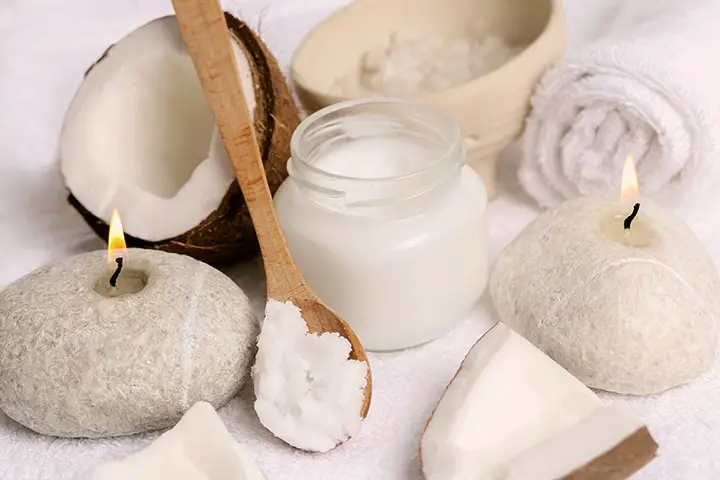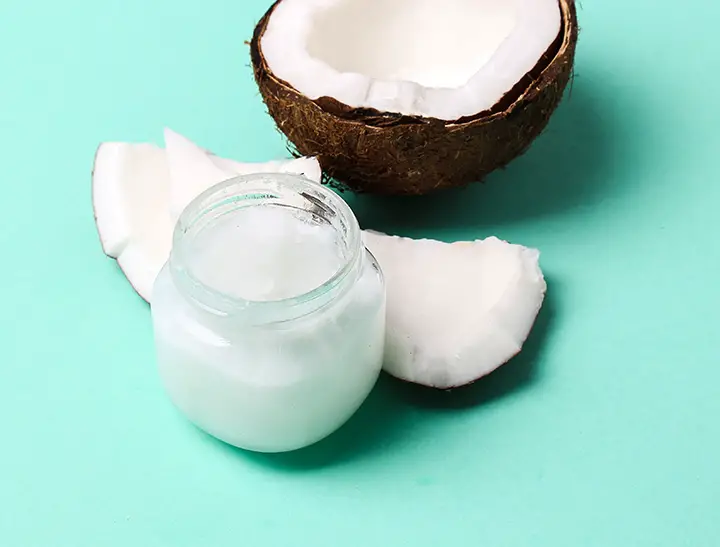
Want to find out how to melt coconut oil? Well, your options are using your own hands, stovetop, microwave, and water bath.
I use coconut oil for a lot of things, including skin and hair care. This means that throughout the years I have had to learn various ways to melt coconut oil based on what I am using it for. And, I decided to share these methods here.
In this post, I talk about why coconut oil has to be melted in a specific way and discuss some of its physical properties. Learn more below!
Related Reading
Understanding the Facts and Hype Behind Coconut Oil
Table of Contents
Here is what you need to know about how to heat up coconut oil
If you live in a warm and balmy area, then you may already find that your coconut oil is more liquid than solid.
In such instances, you will be able to liquefy the coconut oil rather easily.
Scoop out some coconut oil and rub it between the palms of your hands.
The resulting heat should be enough to make the oil liquid enough to be applied to your hair or skin.
One of the main benefits of this method is that it liquefies the coconut oil without causing the oil itself to heat up too much.
Thus, you can immediately apply the oil to your skin or hair without worrying that you will burn yourself.
As you can see, coconut oil will harden whenever the ambient temperature dips below its melting point.
If you live in a particularly cool area, then this may be a problem for you as your coconut oil will consistently be in a solid form.
Make sure to store the coconut oil in a warmer space – perhaps near the stove or an appliance that is frequently switched on.
Now, if you are using coconut oil as a carrier or cooking oil, it is possible for you to mix it with another plant-based oil with a much lower melting point.
This way, the coconut oil will not be able to solidify.
Your other option is to purchase coconut oil that is consistently liquid at room temperature.
For cooking, you will find No products found. to be the best option. It has been designed to remain liquid at cooler temperatures.
At the same time, it is organic and free from any harmful ingredients. It is also odorless, ensuring that the oil doesn’t overwhelm any of the food that you are cooking.
For beauty purposes, look for a fractionated coconut oil. This type of coconut oil is lighter and is more readily absorbed by the skin.
One of the top options for this kind of coconut oil is No products found. fractionated coconut oil. It is all-natural and therapeutic grade. The oil is great for your skin, hair, nails, and more!

It is important to know the melting point of coconut oil when trying to liquefy the oil
The melting point of coconut oil is 78°F.
This means that the melting point tends to be only slightly higher than most ambient temperatures.
As such, it shouldn’t take too much additional heat to melt the coconut oil.
In fact, depending on the season, you may just find that coconut oil remains in a liquid state.
Related Reading
From Head to Toe: The Best Coconut Oils for All Your Needs
It is just as important to appreciate the smoke point of coconut oil.
This is the temperature at which the oil begins to break down and smoke.
Unrefined coconut oil has a smoke point of around 350°F while refined coconut oil boasts one that is slightly higher – 400°F.
Although these temperatures may seem rather high, they actually aren't.
Thus, you do need to be careful when heating your coconut oil to be melted.
If you use a method that provides too much heat, you could cause the oil to start smoking.

If you are going to need to heat a larger amount of coconut oil, you will need to switch gears.
So, does this mean that you can liquefy your coconut oil in the microwave?
Well – yes and no.
A microwave is more than capable of reaching a temperature that will melt the coconut oil.
This isn't the issue, however. The problem is that microwaves reach high temperatures rather quickly.
As a result, your coconut oil can begin to smoke rather quickly.
To prevent this from happening, you have to heat the coconut oil in the microwave carefully.
First of all, heat the oil on a lower temperature setting if possible.
Secondly, match the time to the amount of coconut oil used. So, if you are heating a tablespoon or so of coconut oil, set the timer to five seconds.
In case you will be heating a larger quantity, you can increase the timer appropriately.
It is important, though, to keep stopping the timer every 10 or so seconds to check on the coconut oil. This will prevent the oil from overheating.
Remove the oil from the microwave when most of the coconut oil has melted.
Gently stir the rest of the clumps so that the heat from the surrounding liquid will melt the coconut oil.
It is possible for you to melt the coconut oil in a pan, on the stove.
Once again, though, you have to make sure that the oil doesn’t get too hot.
Add the coconut oil to a pan and place over a low or medium flame. Watch the oil carefully.
Make sure to remove the oil from the heat the moment that it becomes liquid.
If you are cooking with the coconut oil, this is a good time to add garlic, onions, or other ingredients that you may be cooking with.
There is no denying that it can be rather scary to heat up coconut oil in the microwave or on the stove.
A safer method would be to be to use a water bath.
Here, you will simply need to heat some water – you can do this in a kettle or in the microwave.
Make sure that you remove the water from the heat well before it reaches its boiling point.
Coconut oil doesn’t require all that much heat.
Pour the water into a heatproof bowl.
If your coconut oil comes in a durable glass jar or bottle, place the entire container in the bowl of hot water.
Otherwise, scoop out the desired amount of coconut oil into a vessel and place it in the water bath. Make sure that the vessel has taller sides so that the water isn't able to get into the coconut oil.
Then, it is simply a matter of waiting until the coconut oil becomes liquid.
Related Reading
Uncovering the Best Fractionated Coconut Oil
Here's Our Verdict on the Best Coconut Oil for Skin
It is clear that melting coconut oil may not be as clear-cut as you would have thought. It doesn’t matter though as this guide has shown you everything that you need to know.
